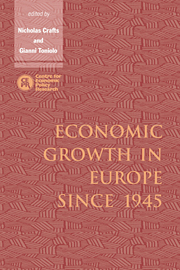Book contents
- Frontmatter
- Contents
- List of figures
- List of tables
- Preface
- List of contributors
- 1 Postwar growth: an overview
- 2 Institutions and economic growth: Europe after World War II
- 3 The varieties of Eurosclerosis: the rise and decline of nations since 1982
- 4 Why the 1950s and not the 1920s? Olsonian and non-Olsonian interpretations of two decades of German economic history
- 5 Convergence, competitiveness and the exchange rate
- 6 British economic growth since 1945: relative economic decline … and renaissance?
- 7 Economic growth in postwar Belgium
- 8 France, 1945–92
- 9 Economic growth and the Swedish model
- 10 Characteristics of economic growth in the Netherlands during the postwar period
- 11 Portuguese postwar growth: a global approach
- 12 Growth and macroeconomic performance in Spain, 1939–93
- 13 Irish economic growth, 1945–88
- 14 Italy
- 15 West German growth and institutions, 1945–90
- 16 An exercise in futility: East German economic growth and decline, 1945–89
- 17 Postwar growth of the Danish economy
- 18 Reflections on the country studies
- Index
4 - Why the 1950s and not the 1920s? Olsonian and non-Olsonian interpretations of two decades of German economic history
Published online by Cambridge University Press: 04 August 2010
- Frontmatter
- Contents
- List of figures
- List of tables
- Preface
- List of contributors
- 1 Postwar growth: an overview
- 2 Institutions and economic growth: Europe after World War II
- 3 The varieties of Eurosclerosis: the rise and decline of nations since 1982
- 4 Why the 1950s and not the 1920s? Olsonian and non-Olsonian interpretations of two decades of German economic history
- 5 Convergence, competitiveness and the exchange rate
- 6 British economic growth since 1945: relative economic decline … and renaissance?
- 7 Economic growth in postwar Belgium
- 8 France, 1945–92
- 9 Economic growth and the Swedish model
- 10 Characteristics of economic growth in the Netherlands during the postwar period
- 11 Portuguese postwar growth: a global approach
- 12 Growth and macroeconomic performance in Spain, 1939–93
- 13 Irish economic growth, 1945–88
- 14 Italy
- 15 West German growth and institutions, 1945–90
- 16 An exercise in futility: East German economic growth and decline, 1945–89
- 17 Postwar growth of the Danish economy
- 18 Reflections on the country studies
- Index
Summary
Introduction
A major puzzle of German economic history in the twentieth century is the fact that the records of the two postwar decades have been so vastly different – a fast and sustained growth leading to full employment in the 1950s, a slow and rather volatile expansion with persistent unemployment in the 1920s. To explain this puzzle, Mancur Olson and some other prominent scholars – notably the economic historians Knut Borchardt and Harold James – have advanced a theory of institutional discontinuity: in essence, they claim that the Weimar Republic of the 1920s suffered from some major institutional weaknesses which gave interest groups a much strong influence to pursue their distributional objectives than was to be the case in the different institutional environment of the later Bonn Republic. In fact, Mancur Olson himself has regarded German economic history as a most important piece of empirical evidence in favour of his celebrated theory of the rise and decline of nations. In this sense, the German case delivers more than just another string of idiosyncratic national history; it is rather a paradigmatic playground for testing one of the most elegant and parsimonious growth theories advanced in the last few decades.
This chapter is no more than a critical note on this ‘Olsonian interpretation’ and an attempt to offer an alternative view that takes the role of interest groups seriously without running into conflict with the basic facts of history. In section 2,1 argue that the major premise of the Olsonian interpretation – the existence of a relatively sharp institutional break between the Bonn and the Weimar Republics concerning the role of distributional coalitions – is untenable.
- Type
- Chapter
- Information
- Economic Growth in Europe since 1945 , pp. 95 - 106Publisher: Cambridge University PressPrint publication year: 1996
- 36
- Cited by



